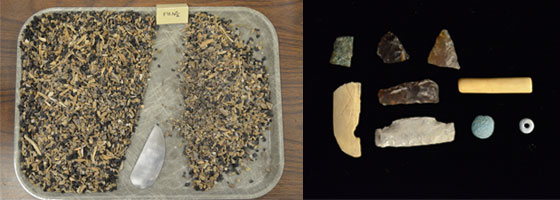What does an archaeological collections assistant do? And (even more importantly) why? Here is a whirl-wind review of some of the things I am involved in and why!
I do a lot of cataloging, photographing, and labeling of archaeological artifacts. North Dakota has an estimated 12 million objects in its state archaeology collection! Unless we record these objects, have a way to identify them, and can find where they are stored, it is very difficult for anyone to study, learn from, look at, or enjoy our collections. This is my favorite part of my job. You never know what you might find next.
I also catalog paperwork relating the collections to the archaeological surveys and excavations from which they were recovered. This is important because the paperwork connects the artifacts to their provenience (where the objects were found). Knowing exactly where objects were found means we can learn things about people living in certain areas of North Dakota at particular times. And knowing exactly where objects were found in relation to other artifacts and features within a site means we can form a clearer picture of how people lived and interacted with the world around them. It makes the stories that the artifacts can tell us much more detailed.
Older collections are sometimes stored in less-than-ideal boxes and materials. In the past, objects were often stored in whatever was available at the time (including window flower boxes, cigar boxes, and old newspapers). We have learned over time that older acidic materials like these (even if they look nice) affect the objects stored in them--the writing on the boxes and bags fade away and the objects stored inside these materials start to crumble or fall apart. We don’t want to lose the collection information on the boxes and bags, and we don’t want to lose the objects themselves! So re-bagging and re-boxing artifacts in archivally stable (acid-free) materials is another big part of my job.

Left - Before: wooden post fragments stored in an unlabeled wooden flower box stuffed with newspaper (Photo by Wendi Murray)
Right - After: wooden post fragments stored in an archival box (complete with label!) and wrapped in acid free tissue for padding and support
I get to work with the archaeology volunteers too, and volunteering involves a fun variety of people and projects. The current main project is sorting objects excavated from the Larson Village site into material types so we can send them to specialists who can tell us more about them. I usually sort some of the smaller sized material, but there are amazing things to be found even there.

Left - A tray of small-sized unsorted materials from the Larson Village site
Right - Fun objects can come in small sizes!
Top Row: a piece of copper, 2 biface or projectile point tips
Bottom Row: part of a bone fish hook, (top) the tip of a stone drilling tool, (bottom) the base of a projectile point (“arrow head”), (top) a bone tube bead, (bottom) 2 glass beads

This is just one row in the new collections space.
There is a lot of variety in this job. The recent expansion project meant that a lot of time has been devoted to planning the layout, labeling the new shelves, and moving collections to the new storage spaces. One of the most exciting parts of the expansion process was being included in some of the new exhibits planning– there was a lot of proof-reading of labels and texts, documenting conditions of objects coming off and going on display, searching for new or different display objects in our collections, tracking the locations of objects, and carting objects to and from the old and new galleries. I love this because it means bringing collections out where people can see and learn about the North Dakota’s extensive past.
In summary, being an archaeological collections assistant involves a lot of documenting, sorting, and re-housing of artifacts. All this is done to help preserve North Dakota’s state archaeology collections and make them available for present and future use.

